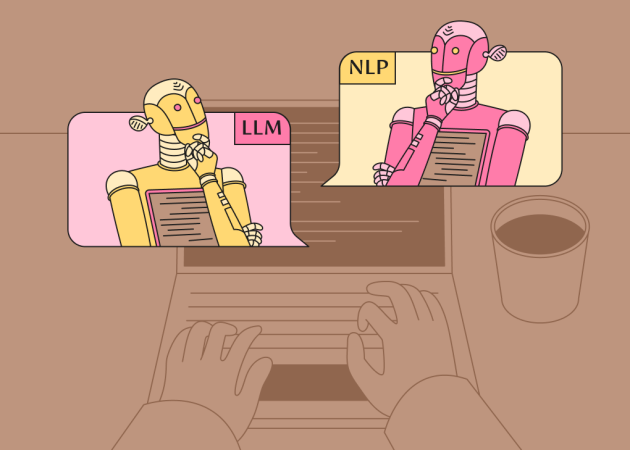
Upskilling in Modern Tech Teams: Building Confidence in AI, Cloud, and Cybersecurity
Contents
Contents
Upskilling — enhancing and developing employees’ existing skills — is the new reality in the tech and business world. While the need for acquiring new competencies is nothing new, the pace at which skills become obsolete has accelerated. Organizations are under pressure to prepare employees to cope with new processes, new technologies, and new market demands.
AI plays a continually more significant role in this transformation. It helps businesses recognize skill gaps more accurately, personalize the learning route, and enhance the strategy for training.
The 2024-2025 Global Talent Trends report from Mercer revealed that 51% of business leaders see employee upskilling as the most powerful lever to enhance productivity, and 40% cite the need to integrate generative AI.
A well-designed upskilling program doesn’t just plug immediate gaps in skills — it primes businesses to adapt to future challenges and develop resilience and long-term growth. In this article, we will explain how to identify skill gaps, practical strategies to upskill teams, ways to avoid common pitfalls, and methods to measure the organization’s return on effort in building future-ready teams.
The Importance of Upskilling in AI, Cloud, and Cybersecurity
Technical skills evolve quickly — many now have a shelf life of just 2.5 years (IBM). As technologies like AI development, cloud computing, and cybersecurity advance, the demand for skilled professionals in these areas grows. Without continuous learning, teams risk falling behind, which can limit innovation, hinder productivity, and impact customer satisfaction.
AI and cloud-based roles like software programmers, data scientists, and cybersecurity specialists are in great demand. The recent surge in the application of AI — highlighted by technologies like ChatGPT — has led to a sharp spike in demand for AI/ML expertise.
A report by IBM’s Institute for Business Values on future workforce readiness found that 40% of the world’s workforce would require reskilling by 2026, driven largely by the integration of AI and automation into business operations.
The O’Reilly 2024 State of Security Survey revealed that nearly 34% of IT staff identify a significant skills gap in AI security, with prompt injection vulnerabilities emerging as a key concern. Cloud security is another major focus, with 39% of respondents citing it as the largest skills shortage despite the cloud’s longstanding presence.
These gaps are alarming, especially as industries beyond tech — such as legal, retail, and education — require employees with foundational knowledge in AI, data security, and cloud-based systems.

Filling these gaps requires something more than traditional training. Specialized programs in AI security, cloud certifications, such as AWS, Azure, or Google Cloud credentials, and hands-on scenario-based training are essential. Team upskilling strategies should also prioritize cross-functional collaboration, enabling them to stay ahead of evolving threats while fostering a continuous learning culture.
Assessing Your Team’s Skill Gaps
Identifying where skill gaps exist is essential for building effective upskilling strategies. Without understanding what’s missing, even the best training programs risk addressing the wrong needs. A structured assessment process ensures that learning initiatives are purposeful, aligned with business goals, and focused on practical outcomes.
Define Skill Requirements
The first step is to clarify which skills are necessary for your team. This involves mapping out the technical, domain-specific, and soft skills tied to each role. Defining these requirements early — ideally during project planning — prevents costly adjustments later on.
Key approaches to defining skill requirements include:
- Work breakdown structures (WBS): Identify tasks and the competencies needed to complete them.
- Role-based analysis: Determine the core skills for each position based on responsibilities and expected deliverables.
- Benchmarking: Align skill expectations with industry standards and project-specific needs.
- Documentation: Create clear criteria to guide consistent evaluations across teams and projects.
Without this foundation, it’s challenging to accurately measure where skills fall short.
Evaluate Current Skill Levels
Once you know what’s required, the next step is to assess your team’s existing skills. This comparison reveals strengths to build on and gaps that need attention. Common methods include:
- Skill audits: Surveys, interviews, and self-assessments provide direct insight into individual capabilities.
- Skill matrices: Visual tools that map proficiency levels across key skills for quick analysis.
- Performance reviews: Leverage past evaluations to identify development areas.
- Direct observation: Watch day-to-day workflows to spot practical skill deficiencies.
- SWOT analysis: Evaluate how current skills align with organizational strengths and potential vulnerabilities.
A combination of these methods provides a comprehensive understanding of the team’s capabilities.
Analyze the Gaps
With both the required and current skills outlined, analyze where discrepancies exist and how they impact project success. Consider factors like:
- Which skills are critical versus nice to have.
- How quickly identified gaps need to be addressed.
- Whether internal development or external hiring is more feasible.
- Risks associated with unaddressed gaps and ways to mitigate them.
Typical outcomes from a gap analysis include:
- No gap: Skills meet current needs.
- Upskilling opportunity: Existing team members can be trained within the project timeline.
- Procurement necessity: Hiring or contracting is needed when timelines don’t allow for internal development.
- Outcome-based solutions: Focus on securing deliverables rather than developing in-house expertise.
Keeping the analysis clear and actionable ensures timely decisions and resource allocation.
Validate Findings with Stakeholders
Once you’ve identified potential skill gaps, it’s essential to validate your findings with key stakeholders. Skipping this stage risks implementing solutions that don’t address real needs or overlook crucial context. Why stakeholder validation matters:
- Practical insight: Team leads and managers often have firsthand knowledge of day-to-day operations that data alone can’t capture.
- Alignment with business objectives: Executives and department heads can confirm that the identified skill gaps align with strategic priorities.
- Holistic understanding: Cross-functional stakeholders (e.g., HR, IT, operations) provide diverse perspectives, ensuring comprehensive gap analysis.
- Resource planning: Stakeholders can advise on the feasibility of addressing gaps within project timelines and budgets.
Validation should refine your initial findings, highlight any overlooked areas, and prioritize gaps based on real-world implications. It’s not uncommon to discover that some gaps initially deemed critical are less impactful than expected, while others, previously underestimated, require urgent attention.
Validate your findings through workshops and focus groups. For more sensitive topics that people might not want to discuss in a group, sit down one-on-one with key stakeholders. When you’re working with larger teams or short on time, use quick surveys and polls to gather insights. To keep things practical, review real project scenarios to understand how skill gaps actually affect your work and ensure that solutions are grounded in reality.

How to Upskill Your Tech Team: Practical Strategies
Implementing effective upskilling strategies is crucial for preparing teams to meet current and future business demands. The World Economic Forum proclaimed the 2020s a decade of upskilling, and LinkedIn’s 2024 Workplace Learning Report ranked it as the top employee retention strategy. To maximize impact, especially when considering upskilling for distributed teams, companies should adopt a structured approach that encompasses the following key strategies:
Review Objectives
The foundation of any upskilling initiative lies in aligning learning efforts with organizational goals. This step involves a thorough review of your company’s strategic objectives, considering technological trends, market shifts, and business priorities.
Collaborating with department heads and senior leaders helps identify the skills needed to achieve both short- and long-term goals. Mapping out current and future skill needs ensures that learning initiatives are targeted and relevant.
Continuously Track Skill Levels
Understanding your team’s current skill set is vital to identifying gaps. Conducting regular skills audits, performance reviews, and gap analyses helps establish a clear baseline. According to Oracle, using a common language to describe skills across departments improves tracking and comparison.
Leveraging technology, such as AI-enabled HCM (human capital management) platforms, allows for real-time monitoring of employee competencies and seamless updates to skill inventories. These systems also help reveal hidden skills employees might possess beyond their job descriptions, providing a more comprehensive view of organizational capabilities.
Set Realistic and Measurable Goals
Setting SMART goals (Specific, Measurable, Achievable, Relevant, Time-bound) ensures learning initiatives are purposeful and actionable. Upskilling goals fall into two categories:
- Organizational: Leadership and HR set goals to align team skills with the organization’s long-term strategy. Using tools like a skills matrix helps identify gaps and plan for future needs, while regular check-ins keep development efforts on track.
- Personal: Employees set individual goals based on how their work contributes to broader business objectives. With manager support, they can map out relevant learning opportunities to grow in their roles and support company success.
LinkedIn’s Workplace Learning Report indicates that employees with defined career goals engage with learning content 4 times more than those without. Goals should consider resource availability, employee capacity, and the expected timeframe for skill development. Aligning these goals with business objectives ensures that upskilling efforts translate into meaningful performance improvements.
Develop and Implement Learning Strategies
Once objectives and skill gaps are clear, it’s time to design tailored learning strategies. Effective approaches include:
- On-the-job training: Assign stretch projects to encourage immediate application of new skills.
- Mentorship programs: Facilitate knowledge transfer between experienced professionals and those developing new competencies.
- Self-paced learning platforms: Provide flexibility, allowing employees to learn at their own pace.
- Instructor-led workshops: Offer deep dives into complex subjects.
- AI-powered learning tools: Personalize learning paths based on individual skill assessments.
A culture of continuous learning helps organizations improve engagement and performance — when people thrive, business thrives. Mentorship programs, in particular, are a win-win for employees and companies. Mentees get career guidance, and mentors often learn from the experience.
These programs boost employee involvement, retention, and knowledge-sharing within organizations. They also support succession planning by helping mentors spot promising talent and preparing employees for key roles.

Track Progress and Measure Impact
Monitoring progress ensures upskilling initiatives remain effective and aligned with organizational goals. Regular assessments, performance reviews, and feedback sessions help evaluate the effectiveness of learning programs. Metrics to monitor include:
- Skill advancement benchmarks
- Project delivery timelines
- Employee retention and engagement rates
- Customer satisfaction improvements
Frequent reviews — quarterly or bi-annually — ensure that any emerging skill gaps are addressed promptly.
Collect and Incorporate Feedback
Gathering feedback from employees participating in upskilling programs is vital for continuous improvement. Encouraging team members to share their experiences helps identify what’s working and what needs adjustment. Oracle’s research emphasizes that employee input can uncover overlooked learning needs and improve program relevance. Regular feedback cycles also foster a sense of ownership among employees, increasing their motivation to engage with upskilling opportunities.
Reinforce Learning Through Practical Application
Training is most effective when new skills are immediately applied in real-world scenarios. Organizations should create opportunities for employees to use their newly acquired competencies through cross-functional projects, leadership roles, or special assignments. Establishing post-training plans ensures that learning translates into improved job performance. Companies that implement practical application strategies see higher skill retention and stronger connections between training and business outcomes.
How to Overcome Common Upskilling Challenges
Companies often face obstacles when implementing upskilling programs, even with a structured approach. According to Pluralsight and the WEF, challenges range from knowledge loss to resource limitations. Addressing these issues requires targeted solutions that prioritize both organizational needs and employee engagement.
Knowledge Loss and Succession Planning
When key employees leave, they often take valuable knowledge with them, disrupting operations and delaying project timelines. This challenge is especially critical for succession planning.
Solution: Implement a knowledge management system that captures critical information. Encourage knowledge-sharing through mentorship programs and regular documentation of processes to ensure valuable expertise remains accessible across teams.
Limited Knowledge of EdTech and LMS Options
Choosing the right learning platforms can be overwhelming, particularly when organizations lack experience with educational technology (EdTech) and Learning Management Systems (LMS).
Solution: Research various LMS solutions by leveraging free trials, vendor consultations, and EdTech forums. Prioritize platforms that are scalable, user-friendly, and align with your organization’s long-term learning goals.
Lack of a Learning and Development (L&D) Strategy
Without a cohesive L&D strategy, upskilling efforts become disjointed and less effective.
Solution: Develop an L&D plan that aligns with both HR objectives and business strategies. Engage stakeholders from different departments to identify diverse skill requirements and review the strategy regularly to adapt to changing needs.
Lack of Internal Expertise in Creating E-Learning Content
Effective e-learning content requires specialized skills many organizations lack internally, slowing program rollout.
Solution: Invest in upskilling your L&D team with content creation training or partner with external providers. Leveraging professional expertise ensures high-quality content that resonates with learners.
Technical Complexity and Cost of Authoring Tools
High costs and technical barriers associated with e-learning authoring tools can stall content development.
Solution: Choose cost-effective, user-friendly authoring tools. Open-source platforms and free trials can be valuable entry points. Provide targeted training to empower non-technical staff to create engaging content.

Lack of Time for Employees to Learn
Pluralsight reports that 42% of technologists cite a lack of time as their top upskilling barrier. Employees often juggle learning with daily responsibilities, making it difficult to prioritize development.
Solution: Offer paid learning time during work hours, for example, dedicating two hours per week to alleviate pressure. Adjust workload expectations to prevent employees from feeling overwhelmed and reinforce learning through team discussions or project-based applications.
Budget Constraints
Limited financial resources can hinder the scope and quality of upskilling initiatives. In fact, 30% of HR and L&D leaders cite budget limitations as a key obstacle.
Solution: Prioritize critical skill areas and explore affordable solutions like open-access courses and government-funded training programs. Demonstrating the ROI of upskilling, like improved retention and faster project delivery, can help justify increased budgets.
Misalignment Between Departments
When HR and tech teams operate in silos, upskilling initiatives risk being ineffective. Pluralsight highlights that 17% of HR leaders face challenges collaborating with tech departments.
Solution: Foster cross-departmental collaboration by involving tech leaders in planning and execution. Regular joint meetings can ensure that upskilling efforts address real-world challenges and align with operational needs.
Inadequate Learning Resources
Technologists often struggle with unclear learning paths and insufficient resources, with 25% citing uncertainty about where to focus their efforts.
Solution: Create clear, structured learning paths tailored to organizational goals. Combine self-paced courses with hands-on projects, instructor-led sessions, and mentorship to enhance skill application and retention.
Eliminating these obstacles boosts employee engagement and equips teams to achieve organizational goals. By proactively removing learning barriers, companies can increase productivity, improve retention, and stay prepared for future demands.
Measuring the ROI of Upskilling
As organizations invest significantly in team IT upskilling in emerging areas like AI, cloud computing, and cybersecurity, it’s only natural to wonder if these efforts are paying off. According to Training Magazine, measuring the effectiveness of upskilling programs becomes crucial for securing leadership buy-in and future improvements. Tracking ROI helps justify the investment and secure stakeholder support while ensuring the upskilling programs remain aligned with business goals and employee development needs.
Key Metrics to Track
Effective ROI measurement combines both quantitative data and employee feedback:
1. Employee performance improvements
Compare pre- and post-training metrics to assess gains in productivity and work quality:
- Faster task completion times
- Fewer errors and rework
- Higher-quality project outcomes
2. Skill application
Go beyond course completion rates. Use practical assessments and project assignments to verify how employees apply new skills in their daily work.
3. Cost savings
Compare the expenses of upskilling existing team members against the costs of hiring new technical talent externally. This includes evaluating recruitment costs, onboarding time, and ramp-up periods for new hires.
4. Employee engagement and satisfaction
Collect feedback through surveys to measure morale and motivation improvements, which can correlate with productivity and retention.
5. Business impact
Link upskilling to key performance indicators (KPIs), such as:
- Revenue growth
- Enhanced operational efficiency
- Accelerated project delivery
- Improved customer satisfaction through better technical solutions
- New revenue streams enabled by technical innovations
- Reduced operational disruptions due to technical issues
ROI Calculation Framework
You can calculate the ROI of upskilling using the following formula:
ROI (%) = ((Net Benefit from Upskilling – Total Investment) / Total Investment) × 100
When calculating the total investment, include:
- Direct costs: Training programs, materials, and technical resources
- Indirect costs: Time spent by employees in training sessions
- Administrative overhead: Program management and coordination
Continuous Evaluation
Implement a continuous evaluation process that includes:
- Regular performance assessments to track technical skill progression
- Employee feedback surveys to gauge satisfaction and confidence levels with new technologies
- Comparison with industry benchmarks to ensure competitiveness
- Analysis of technical team retention rates and internal mobility
By taking a comprehensive approach to measuring ROI, companies can better understand the outcomes of their upskilling initiatives and make informed decisions about future investments in technical training and development.

Tools and Resources to Upskill Your Employees
Choosing the right tools and learning methods can make all the difference in how effectively your team develops new skills. A balanced approach is a mix of self-paced learning, upskilling platforms, software, and collaborative training environments. With so many options available, it’s important to focus on solutions that engage employees, fit seamlessly into their workflows, and produce measurable results.
Learning Approaches That Work
Flexible online courses: These solutions are ideal for building foundational knowledge in areas like AI, cybersecurity, and cloud computing. On-demand platforms like Coursera and Pluralsight let team members learn at their own pace, earning certifications while balancing their daily responsibilities.
Instructor-led training and workshops: Sometimes, there’s no substitute for real-time interaction. Instructor-led sessions — whether in-person or virtual — give employees a chance to ask questions, solve problems, and apply concepts on the spot.
Hands-on learning and simulations: Practical experience helps new knowledge stick. Platforms such as AWS CloudQuest or Cyberbit provide immersive simulations where teams can practice responding to real-world challenges in a safe environment.
Blended learning models: Combining online self-paced modules with live training ensures that learning is both flexible and interactive. This approach caters to different learning preferences, helping to improve knowledge retention and engagement.
Technology That Supports Effective Upskilling
Learning Management Systems (LMS) and Experience Platforms (LXP): Learning and upskilling software like Moodle and Degreed offer a centralized way to manage courses, track progress, and personalize learning journeys. LXPs, in particular, use AI to recommend content tailored to individual needs, making learning more relevant and engaging.
Micro-learning platforms: These tools improve knowledge retention through focused, easily digestible content. Solutions like EdApp or Axonify provide short, focused lessons that employees can complete during breaks or between tasks—helping them absorb information without feeling overwhelmed.
Digital adoption and knowledge-sharing tools: Platforms like WalkMe and Whatfix provide in-app guidance and simulations, ensuring employees fully utilize workplace technologies. Knowledge repositories like Confluence and SharePoint centralize documentation, enabling ongoing access to best practices and procedures.
Collaboration and communication tools: Popular work chat tools like Slack and Microsoft Teams not only improve communication but also encourage peer-to-peer learning through discussion channels, shared resources, and mentorship connections.
Key Features to Consider in Upskilling Tools
When selecting upskilling solutions, focus on features that truly benefit your team’s learning experience:
- Personalized learning routes tailored to individual skill gaps and career goals.
- Clear progress tracking with analytics to measure learning outcomes and ROI.
- Mobile accessibility for learning anytime, anywhere.
- Seamless integration with existing HRIS, CRM, and project management tools.
- Interactive features like live polls, simulations, and collaborative assignments.
- Compliance with data security standards to protect sensitive information.
Finding the right mix of tools and methods helps create an upskilling strategy that’s not just effective but also enjoyable for your team — ensuring they’re qualified for today’s challenges and ready to tackle what’s next.

How Beetroot Helps Organizations Upskill Successfully
Addressing skills gaps in areas like AI, cybersecurity, and cloud technologies requires more than just off-the-shelf solutions. Recognizing that every organization faces unique challenges, Beetroot offers customized training designed to help teams gain practical, job-ready skills. Our approach focuses on empowering your employees with relevant knowledge through hands-on learning experiences that translate directly into workplace productivity:
- Tailored, hands-on training that meets real business needs: Generic training often lacks practical impact. Our Academy’s tailored workshops focus on your organization’s goals, helping teams grasp complex topics like AI, cybersecurity, and compliance through real-world applications. Employees gain skills they can immediately apply in their work.
- Practical learning from industry experts: Participants develop skills directly applicable to their roles, with immediate feedback and hands-on exercises from real-world professionals. Each workshop is tailored to your business goals, offering flexible group sizes, focused sessions, and practical applications across topics like AI, cybersecurity, cloud technologies, web accessibility, and green coding.
- Structured approach for maximum impact: Our training solutions begin with a thorough needs analysis to align learning with organizational goals and identify required skills. Based on these insights, we design a tailored plan with expert instructors and targeted content addressing specific challenges.
- Supporting long-term skill retention: To ensure lasting impact, Beetroot incorporates post-training evaluations and practical assignments. These follow-ups help solidify new knowledge, making sure your team not only learns but retains and applies what they’ve gained.
- Addressing compliance and regulatory challenges: Strict regulations, particularly in AI ethics, data privacy, and cybersecurity have become a pressing concern for many organizations. Our training helps teams navigate regulatory standards, ensuring technical upskilling aligns with legal requirements while reducing risks and strengthening operations.
- A focus on real-world application, not just theory: Beetroot’s commitment to practical, actionable learning ensures that your teams develop the skills they need to meet today’s challenges and tomorrow’s opportunities.
Looking ahead, continuous skill development is no longer optional — it’s key for maintaining competitiveness, securing digital environments, and preparing teams for the future of work. Investing in the right upskilling platforms and strategies ensures your organization remains agile, competitive, and resilient. Upskill your employees with solutions that deliver measurable benefits, support career growth, and foster an innovative culture. Ready to remove barriers and accelerate your team’s development? We’re here to provide the tools, guidance, and expertise you need.
Subscribe to blog updates
Get the best new articles in your inbox. Get the lastest content first.
Recent articles from our magazine
Contact Us
Find out how we can help extend your tech team for sustainable growth.







